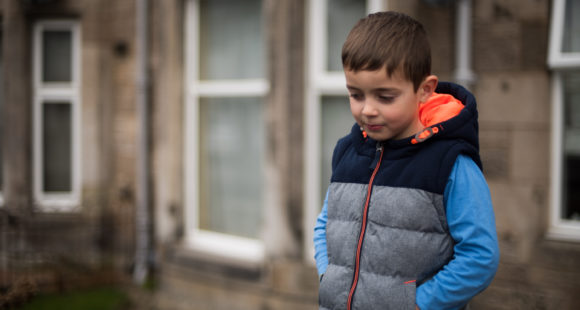Paola Scommegna
Contributing Senior Writer

But common waitlist practices disadvantage families facing greatest hardships, analysis finds
May 10, 2023
Contributing Senior Writer
However, up to 75% of renters who need federal housing assistance—including public housing or rental vouchers—don’t receive it, data show. Most households that get assistance have incomes below the federal poverty line ($30,000 for a family of four in 2023) and a sizeable share live in deep poverty.2
Families receive rental assistance in three main forms:
But common waitlist processes for housing vouchers inadvertently favor more stable families, compounding the disadvantage for those facing the greatest hardships, another new study shows. 3
Public housing buildings have been widely criticized for isolating disadvantaged families, and media have focused on disrepair. But for families struggling to pay rent and facing the threat of eviction, “receiving housing assistance is like winning the golden ticket,” says Andrew Fenelon, a sociologist and demographer at Penn State University.
Children in households with rental assistance had fewer health problems and missed 22% fewer school days for illness compared with children whose households were waiting for assistance, Fenelon and colleagues found.
His research team examined the impact of rental assistance by comparing children in households receiving assistance with those in households that would receive it within two years. They used the National Health Interview Survey (NHIS), a nationally representative dataset, linked with administrative records on housing assistance from the US Department of Housing and Urban Development (HUD) for 1999 to 2014.

Children in households with rental assistance had fewer health problems and missed 22% fewer school days for illness compared with children whose households were waiting for assistance.
Fenelon suspects that the stability rental assistance offers families helps them better manage asthma—a major health reason children miss school. In an earlier study of NHIS and HUD data, Fenlon and colleagues found that children in households with rental assistance were less likely to go to the emergency room for a recent asthma attack than those in households awaiting assistance.4
Children in public housing tend to have more health problems than their peers who live elsewhere, including more frequent diarrhea, headaches, skin allergies, and asthma. But public housing does not make kids sicker, Fenelon found in another analysis of NHIS and HUD data.5
Investment in affordable and stable housing can boost school attendance by promoting better health, Fenelon says. Healthier kids do better in school and stay in school longer, creating long-term socioeconomic benefits, Fenelon argues.
“Disadvantaged families in public housing tend to have many challenges, but the inability to access stable and affordable housing is not one of them,” Fenelon says. With a reduced rent burden, families can invest more in their children, and with more stability they can better manage their children’s health care needs, he argues.
In a separate study, receiving a housing voucher during childhood was strongly linked to lower hospitalization rates and less inpatient spending during young adulthood.6
Craig Evan Pollack of Johns Hopkins University and team analyzed data from the Moving to Opportunity (MTO) program, which tracked more than 4,600 families in five cities receiving either a traditional housing voucher, a voucher that could only be used in a low-poverty neighborhood, or no assistance between 1994 and 1998. Families in the two voucher groups lived in neighborhoods with similar poverty levels, and the program followed up with them 11 to 21 years later using hospital discharge and Medicaid data.
Looking at the reasons for hospital admissions, Pollack and colleagues found that children whose families received vouchers had significantly lower admission rates for asthma and mental health disorders compared to the control group.7 In contrast, there was no difference in emergency department use between the two groups.8 The findings suggest that housing policies that reduce childhood exposure to neighborhood poverty can reduce health care use into adulthood.
Another study using MTO data linked receiving a housing voucher to improved mental health among girls and fewer behavioral problems among boys when families moved to neighborhoods with less social disorder, Nicole M. Schmidt of the University of Minnesota and colleagues show.9 Social disorder was defined as public drinking, loitering, and police not coming when called.
By contrast, children were more likely to engage in delinquent behaviors in families that experienced housing hardship, reports Sarah Gold of Princeton University. Her findings are based on an analysis of the Future of Families and Child Wellbeing Study, which followed nearly 5,000 children born in large U.S. cities from 1998 to 2000.10
Housing hardship includes eviction, moving in with another household, homelessness, being unable to pay the rent or mortgage, and frequent moves. More severe or longer periods of housing hardship were associated with increased delinquent behavior such as vandalism, drug use, and assault. Delinquent behavior can lead to school suspension or expulsion, with lasting ramifications, Gold noted.
The link between housing hardship and delinquent behavior was the same for children in families with and without low incomes, suggesting that parental stress plays a role and that housing assistance may reduce stress.
“Children living in households with housing hardship may experience greater levels of family stress, which is linked to increased parental psychological stress and changes in parenting, which can lead to problematic behaviors in children,” writes Gold.
“Not only do children experience stress through their parents, but experiencing their own stress is linked to impulsivity, withdrawal, and aggression, all of which are associated with subsequent delinquent behavior,” she explains.

The way housing voucher waitlists are managed unintentionally favors stability, disadvantaging families with the lowest incomes who move often.
The way housing voucher waitlists are managed unintentionally favors stability, disadvantaging families with the lowest incomes who move often, Huiyun Kim of the University of Minnesota documents. 11
Using administrative data and interviews with local housing authorities, Kim identified common practices that make it difficult for unstable families to compete for spots. These include giving preference to applicants who continue to live in the jurisdiction and purging applicants who do not respond to a mailing about their interest—often because they have moved.
Keeping shorter waitlists with more frequent openings, tracking applicants in multiple ways, and cooperating with neighboring jurisdictions could help level the playing field, Kim says.
Policy changes, including making more families eligible for housing assistance and increasing funding so more families can get help, would promote a more equitable system and lift more families out of poverty, he adds.
“By providing stable and affordable places to live, housing assistance deactivates an important way poverty is reproduced and reinforced,” Kim argues.
Stability, says Fenelon, is a key benefit that public housing offers struggling families.
Eviction can be devastating for families and children, Fenelon notes. Public housing authorities tend to have policies that protect tenants from evictions that private landlords who accept vouchers do not offer. Policymakers should consider ways to build the same stability into voucher programs, he says.
In addition, children in households with rental assistance often live in high-poverty neighborhoods, he reports. “Policymakers should consider the potential benefits to children and families of investing in parks, sidewalks, public transportation, libraries and other institutions in those neighborhoods.”
This article was produced under a grant from the Eunice Kennedy Shriver National Institute of Child Health and Human Development (NICHD). The work of researchers from the following NICHD-funded Population Dynamics Research Centers was highlighted: Pennsylvania State University, University of Minnesota, Princeton University, and Johns Hopkins University.
Photo Credits
Header: Tetra Images
Photo 1: Steven Robinson Pictures
Photo 2: SDI Productions
